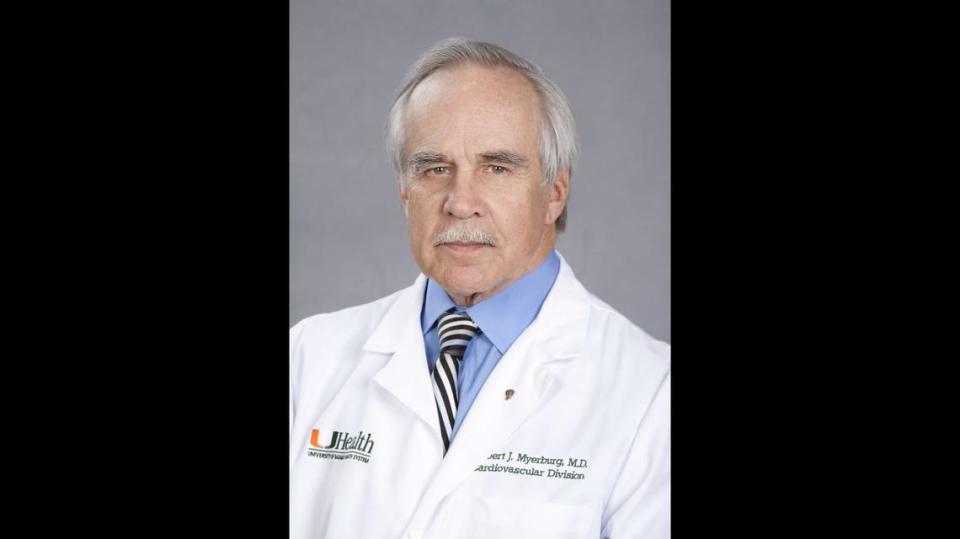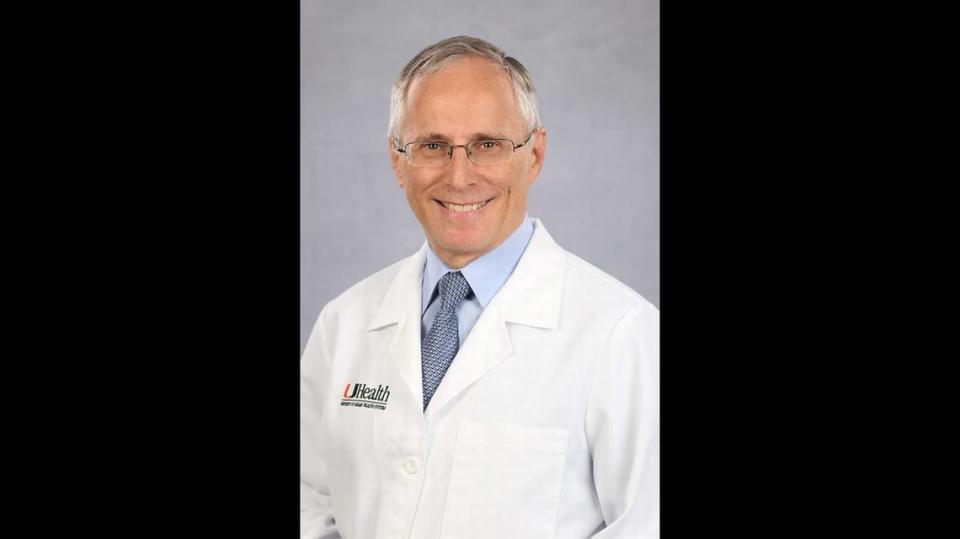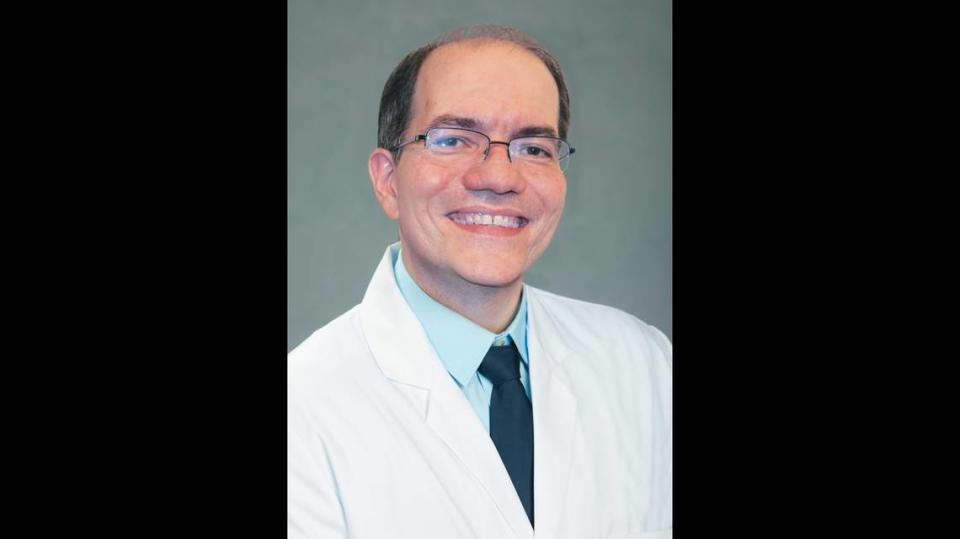She had gone out to dinner with her daughter. She then collapsed on the table
In a heartbeat, Esperanza Pérez’s life nearly ended at 62 during a vacation meal out with her daughter.
“We had gone into a restaurant to eat dinner. I’ll tell you her recount because I don’t remember what happened,” said Pérez, who was in San Francisco nine years ago visiting daughter Beatriz Rambarran. “We were sitting down, getting ready to eat. She said I put my hand on my forehead, and I leaned forward and she asked me if I was dizzy. I just said, ‘Hmm hmm.’
“And then, she said, I collapsed on the table. She realized something was really seriously wrong. Somebody helped her to put me down on the floor. She wasn’t sure what was going on. She said I became really rigid. People thought I was having a seizure and she knew I wasn’t.”
Pérez, now a retired Miami medical worker, had suffered sudden cardiac arrest, which kills about 400,000 Americans every year.
A quick response by her daughter and others in the restaurant — along with extremely good luck — helped save Pérez’s life: Beatriz shouted to call 911; a nurse who also was dining that night gave Pérez CPR; and fire rescue workers arrived quickly with defibrillation equipment to restore her pulse.
“They gave me those electrical shocks,” said Pérez, now 70. “The first set didn’t work. The second set didn’t work. Finally, the last set, with some medication, they were able to bring my heart to beating and they took me to the hospital.”
Pérez’s cardiac arrest came suddenly without warning, but now she realizes that the warning sign was always there — her family history. She inherited a gene that caused both her mother and grandmother to die in their early 70s of sudden cardiac death, and that nearly killed her older brother when he was 62.
Genetic causes, family histories
“Between 35 and 70 percent of people prone to cardiac arrest due to a genetic cause will have an identifiable gene, depending upon the specific genetic disease,” said Pérez’s physician, Dr. Robert Myerburg, a Miami cardiac electrophysiologist at UHealth, the University of Miami Health System. “The reason that’s valuable is that it gives us the opportunity to look at other family members.”

There’s a 50 percent chance that each child born to a mother or father with the gene will inherit it. It doesn’t skip generations, so if a child does not inherit the gene, his or her children won’t inherit it, either.
Pérez’s older daughter Beatriz tested for the gene and she doesn’t carry it. Younger daughter Patricia, however, does and her two young sons will soon be tested for it.
Testing has traditionally been by drawing blood, but today can be more easily done through an inexpensive, noninvasive saliva swab, Myerburg said.
Some genetic abnormalities, such as one called Long QT syndrome, can be picked up on an EKG, he said.
Long QT syndrome causes a heart rhythm condition that can potentially cause fast, chaotic heartbeats, according to the Mayo Clinic. “These rapid heartbeats might trigger you to suddenly faint. Some people with the condition have seizures. In some severe cases, LQTS can cause sudden death.”
Defibrillator inserted into her chest
To help maintain normal heart rhythms, Pérez and her younger daughter have each had implantable cardioverter defibrillators surgically inserted into their chests.
An ICD “monitors the patient and if they were ever to have a heart rhythm problem like ventricular tachycardia or ventricular fibrillation, it would automatically provide a shock to restore the heart rhythm to normal,” said Dr. Jeffrey Goldberger, also a UHealth electrophysiologist.

Sudden cardiac death, according to Goldberger, is “the death of somebody who has otherwise been well and dies unexpectedly of a cardiac cause.”
“We’re not talking about people who are in the hospital with heart failure and then during hospitalization they die,” he said. “You’re typically talking about the kind of person that, ‘Yeah, I was talking to him yesterday and everything was fine. And then I just heard, you know, five minutes later, he dropped dead.’”
Heart rhythm disorders are the main issue
Most sudden cardiac deaths are not caused by long-term disease that causes the heart muscle to gradually weaken and die, but by heart rhythm disorders, Goldberger said.
And 90 percent of sudden cardiac arrests that happen outside of a hospital like the one Pérez suffered are fatal, he said.
Overall, 50 percent of sudden cardiac arrests are first cardiac events in patients who did not have previously identified risks or known heart disease, Myerburg said.
Survival depends on where someone suffers cardiac arrest and whether they’re asleep at the time or home alone, according to Myerburg.
“If we look at patients who have a cardiac arrest at home, which is the majority of cardiac arrests, the survival rate is 6 percent,” he said. “If they occur out in the public and two conditions are met — one is that there’s a bystander there who knows CPR and access to an automated external defibrillator — that combination gets you up to somewhere between 16 and 20 percent survival.”
Quick action needed to survive
But action must be taken within minutes, Myerburg said.
“Once you hit five minutes, the survival rate falls below 50 percent — five minutes from onset of cardiac arrest until restoration of a pulse,” he added. Very few survive beyond 10 minutes without a pulse.
For people over the age of 35, the incidence of sudden death is 1 to 2 per 1,000 people annually; 1 in 100,000 for adolescents and young adults, according to Myerburg.
“If you extrapolate that out to the number of people in the population, which is 300 million in the United States, you can see the number gets really big,” he said.
Coronary artery disease may affect people as early as their mid 30s and increases progressively up to their mid 60s, Myerburg said.
Once a patient reaches their 70s, “cancer takes over as the most common cause,” he said. “Coronary disease doesn’t disappear. But if you look at causes of death, cancer gets a little higher.”
Teens not immune from sudden cardiac death
Children and teens also are susceptible to sudden cardiac death, said Dr. Kak-Chen Chan, chief of pediatric congenital cardiovascular interventional services at Joe DiMaggio Children’s Hospital in Hollywood.

Joe DiMaggio offers free EKG screenings for families worried about the risk, said Chan, a pediatric cardiologist.
It’s usually big news when a local high school athlete dies suddenly during a game or practice, Chan said. “We lose them on the field doing what they do best.”
These young people usually are fine during “everyday living,” but are at high risk participating in “really aggressive sport activities,” he said.
Chan said it’s most important to “counsel the family, to reassure them that once you know the diagnosis and we treat them, the risk is remarkably reduced.”
That often means cutting out “extreme exercise,” Chan said.
“We would prescribe exercise modification or activity modification and limitation. In general, competitive sports are out,” he said. No power or anaerobic sports such as weightlifting or chinning.
“The other thing we would say is, don’t go swimming or climbing on your own. Preferably no climbing because with Long QT syndrome, when they get the attack, they lose consciousness. If you’re at a height, you fall; if you’re in the water you’re going to drown.”
Limited aerobic sports are encouraged. And “they could play competitive chess,” he said.
Young at-risk patients can be treated with ICDs and beta blockers, which are medications that slow the heartbeat.
In 2020, Joe DiMaggio treated 29 young patients with Long QT syndrome and eight of them required ICDs. The hospital also treated about 100 patients with cardiomyopathy, a heart muscle disease that is often inherited and makes it difficult for the heart to pump blood.
Beyond genetics, there are other ways to determine risk of dying from inherited heart disease or sudden cardiac arrest.
“Those factors are usually grouped into modifiable risk factors and non modifiable. There are certain things that increase your risk of heart disease, which you cannot modify, like your genetics or your age,” said Dr. Alexandre Ferreira, who specializes in interventional cardiology at Miami-Dade County’s Jackson Health System.

“It’s important for people to understand that as you get older or if you have family history of heart disease, that increases your risk of heart disease. If there is a relative — a first-degree relative, either your parents or brothers or sisters — that significantly increases your risk of heart disease, particularly if your family members developed heart disease at a younger age.”
High blood pressure, high cholesterol and smoking boost your risk
Modifiable risk factors include hypertension, high cholesterol and smoking. “Those are things that you can avoid and treat to reduce your risk of heart disease,” Ferreira said.
Jackson Health System this month launched an online tool called “Learn Your Heart Age,” which helps website visitors determine risk based on basic health information such as height, weight, blood pressure, diabetes, family history, etc.
“There are specific algorithms which were designed based on studies on large populations that can give you a probability of a cardiovascular event, either a heart attack or stroke in the next 10 years,” Ferreira said. “Those algorithms are very accurate. They tell you what the probability of an event is in 10 years. Is it 5 percent? Is it 10 percent?”
Ferreira said it’s hard for most patients to understand exactly what that means.
“What’s more important is for patients to understand that they are at increased risk, and what are the measures they can do to reduce that risk,” he said. “The next step is for patients to discuss with their physicians. The whole objective is for patients to be more aware that they are at an increased risk, and then be proactive about what they can potentially do to reduce the risk.”
To learn more
▪ Jackson Health System’s new “Learn Your Heart Age” online tool is available at https://learnyourheartage.org.
▪ Joe DiMaggio Children’s Hospital offers pediatric EKG testing. For more information, visit https://www.jdch.com/services/cardiac/services/electrocardiogram or call 954-265-3437.
▪ UHealth, the University of Miami Health System, has a webpage dedicated to providing information about sudden cardiac death. Visit https://news.umiamihealth.org/en/focusing-on-you-sudden-cardiac-death.

 Yahoo Finance
Yahoo Finance 